Technology
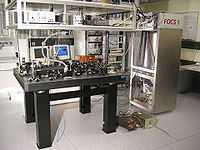
"Technology is the making, usage, and knowledge of tools, machines, techniques, crafts, systems or methods of organization in order to solve a problem or perform a specific function."[1]
"It can also refer to the collection of such tools, machinery, and procedures. Technologies significantly affect human as well as other animal species' ability to control and adapt to their natural environments."[1]
Technologies
"In 1937, the American sociologist Read Bain wrote that "technology includes all tools, machines, utensils, weapons, instruments, housing, clothing, communicating and transporting devices and the skills by which we produce and use them."[2] Bain's definition remains common among scholars today, especially social scientists."[1]
"[E]qually prominent is the definition of technology as applied science, especially among scientists and engineers, although most social scientists who study technology reject this definition.[3]"[1]
"The Merriam-Webster dictionary offers a definition of the term: "the practical application of knowledge especially in a particular area" and "a capability given by the practical application of knowledge".[4]"[1]
"Ursula Franklin, in her 1989 "Real World of Technology" lecture, gave another definition of the concept; it is "practice, the way we do things around here".[5]"[1]
"Bernard Stiegler, in Technics and Time, 1, defines technology in two ways: as "the pursuit of life by means other than life", and as "organized inorganic matter."[6] ... Stiegler has more recently stated that biotechnology can no longer be defined as "organized inorganic matter," given that it is, rather, "the reorganization of the organic."[7]"[1]
"Technology can be most broadly defined as the entities, both material and immaterial, created by the application of mental and physical effort in order to achieve some value. In this usage, technology refers to tools and machines that may be used to solve real-world problems. It is a far-reaching term that may include simple tools, such as a crowbar or wooden spoon, or more complex machines, such as a space station or particle accelerator. Tools and machines need not be material; virtual technology, such as computer software and business methods, fall under this definition of technology.[8]"[1]
Clocks
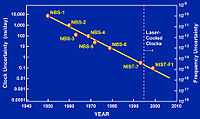
"An atomic clock is a clock device that uses an electronic transition frequency in the microwave, optical, or ultraviolet region[9] of the electromagnetic spectrum of atoms as a frequency standard for its timekeeping element. Atomic clocks are the most accurate time and frequency standards known, and are used as primary standards for international time distribution services, to control the wave frequency of television broadcasts, and in global navigation satellite systems such as GPS."[10]
The FOCS 1 continuous cold cesium fountain atomic clock at the top of the page started operating in 2004 at an uncertainty of one second in 30 million years. The clock is in Switzerland.
Laboratory
Template:Main:Laboratory
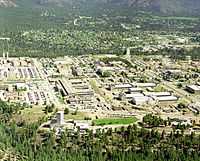
A laboratory is a construct you create so as to produce reproducible measurements.
Def. "a room, building or institution equipped for scientific research, experimentation or analysis"[11] is called a laboratory.
Measurements
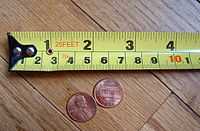
Def. any act of quantifying relative to a standard is called a measurement.
In the image on the right are three diverse technologies:
- a typical tape measure with both metric and US units is shown to measure
- two stamped US pennies, on a
- parquet flooring.
Musics
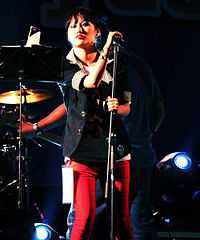
One such talented musician from Manipur who has used YouTube to share music to the world is June Neelu. The usage of free and open software itself translates into a counter hegemonic development against the dominant paradigm of the recording industry.
Plasmas
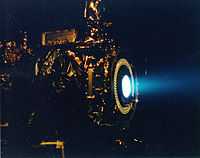

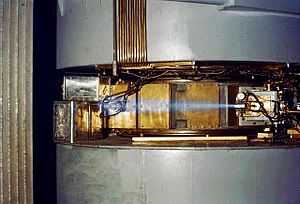
The image in the center shows a blue glow in the surrounding air from emitted cyclotron particulate radiation.
At left is an image that shows the blue glow resulting from a beam of relativistic electrons as they slow down. This deceleration produces synchrotron light out of the beam line of the National Synchrotron Light Source.
"Plasma cleaning involves the removal of impurities and contaminants from surfaces through the use of an energetic plasma created from gaseous species. Gases such as argon and oxygen, as well as mixtures such as air and hydrogen/nitrogen are used. The plasma is created by using high frequency voltages (typically kHz to >MHz) to ionise the low pressure gas (typically around 1/1000 atmospheric pressure), although atmospheric pressure plasmas are now also common."[12]
Original research
- See also: Original research inquiry and Research
Hypothesis:
- Technology is an opportunity to use materials or thinking and conceiving in the abstract to alter the course of events so that life forms having such facility can survive.
- See also: Control groups, Proof of concept, and Proof of technology
See also
References
- 1 2 3 4 5 6 7 8 "Technology, In: Wikipedia". San Francisco, California: Wikimedia Foundation, Inc. October 9, 2013. Retrieved 2013-10-10.
- ↑ Read Bain, "Technology and State Government," American Sociological Review 2 (December 1937): 860.
- ↑ Donald A. MacKenzie and Judy Wajcman, "Introductory Essay" in The Social Shaping of Technology, 2nd ed. (Buckingham, England : Open University Press, 1999) ISBN 0-335-19913-5.
- ↑ "Definition of technology". Merriam-Webster. Retrieved 2007-02-16.
- ↑ Franklin, Ursula. "Real World of Technology". House of Anansi Press. Retrieved 2007-02-13.
- ↑ Stiegler, Bernard (1998). Technics and Time, 1: The Fault of Epimetheus. Stanford University Press. pp. 17, 82. ISBN 0-8047-3041-3.
- ↑ Stiegler, Bernard (2008). L'avenir du passé: Modernité de l'archéologie. La Découverte. p. 23. ISBN 2-7071-5495-4.
- ↑ "Industry, Technology and the Global Marketplace: International Patenting Trends in Two New Technology Areas". Science and Engineering Indicators 2002. National Science Foundation. Retrieved 2007-05-07.
- ↑ Dennis McCarthy, P. Kenneth Seidelmann (2009). TIME from Earth Rotation to Atomic Physics. Weinheim: Wiley-VCH. ch. 10 & 11.
- ↑ "Atomic clock, In: Wikipedia". San Francisco, California: Wikimedia Foundation, Inc. October 12, 2012. Retrieved 2012-10-24.
- ↑ "laboratory, In: Wiktionary". San Francisco, California: Wikimedia Foundation, Inc. September 21, 2013. Retrieved 2013-09-30.
- ↑ "Plasma cleaning, In: Wikipedia". San Francisco, California: Wikimedia Foundation, Inc. April 13, 2013. Retrieved 2013-05-28.
External links
| |||||||||||||||||||||||||||||||||||||||||
![]() This is a research project at http://en.wikiversity.org
This is a research project at http://en.wikiversity.org
| |
Educational level: this is a research resource. |
| |
Resource type: this resource is an article. |
| |
Resource type: this resource contains a lecture or lecture notes. |
| |
Subject classification: this is a technology resource . |